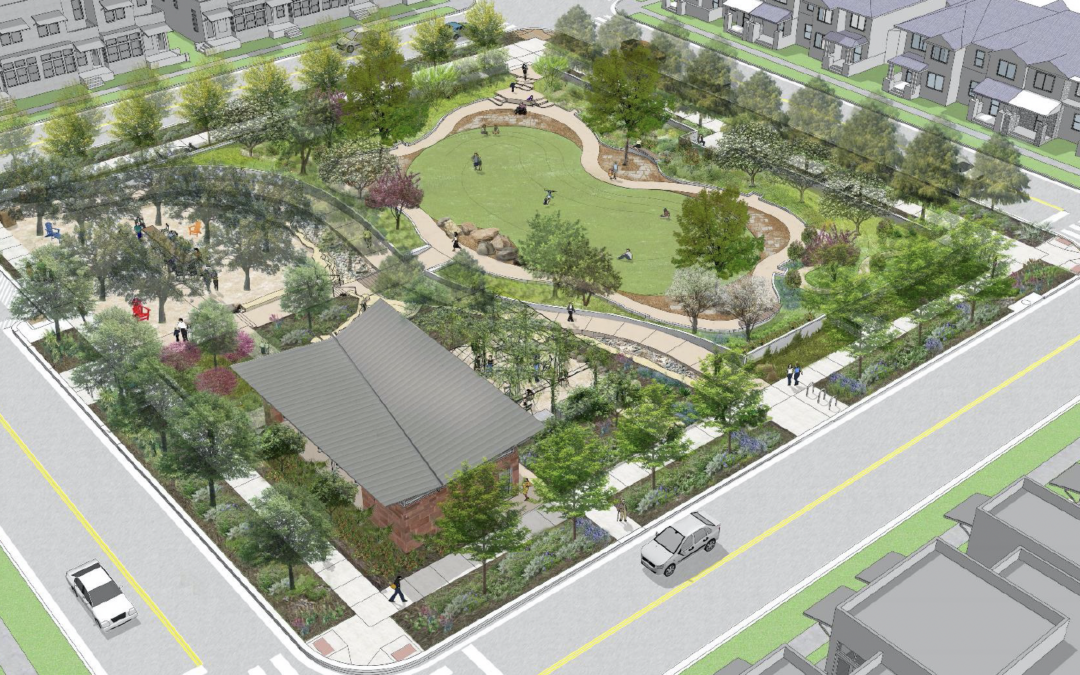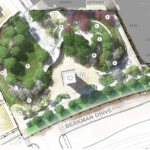Many of Mueller’s parks are named after remarkable individuals who have made significant contributions to Austin, and now three new names join this prestigious list. Read the full stories of these namesakes and the stories of the other local legends for whom Mueller’s parks are named.
About Roger Taylor: Roger Lavon Taylor, Sr. was born in May 1935 in Austin. He graduated from the original Anderson High School in 1954. He joined the U.S. Army and was honorably discharged in 1958 after serving as a mechanic. After studying Business Administration at Austin Community College, Taylor then served 30 years as the Mail Room Supervisor for the Veterans Administration. In 1962, the Taylor family moved to just south of the former Mueller airport and, in 1982, he founded the J.J. Seabrook Neighborhood Association, where he served as president for 13 years. He was an active member of the Citizens for Airport Re-Location (CARE) group that established a first redevelopment plan for the airport. He was also a dedicated member of the RMMA Airport Advisory Committee and the Mueller Coalition. His most sizable contribution to Mueller was his effort to successfully save the former control tower from demolition. He passed away in November 2012.
About Eva Carrillo de Garcia: Eva Carrillo was born in 1883 in Los Angeles. After her mother’s death and her father’s remarriage when she five, she became the ward of a medical missionary in Mexico. After graduating from schools in Guanajuato, Mexico; Larned, Kansas; and Chicago, she worked as a nurse at a Michigan sanitarium, where she met her husband Dr. Alberto Garcia. They had eight children, six of whom attended UT. Five years after moving with her family in 1915 to Austin, she and Alberto published Austin’s first Spanish-language newspaper, La Vanguardia. She helped found the second Mexican Methodist church in Austin and taught Spanish to students from the Austin Military Academy. She was a founding member and president of the Ladies LULAC and was active in the League of Women Voters of Texas. In these roles, she worked to desegregate movie theaters and swimming pools, and fought to improve underfunded schools by encouraging others to buy property, vote, pay the poll tax and defend their rights. She passed away in 1979.
About Isamu Taniguchi: Isamu Taniguchi was born in Osaka, Japan, in 1898 and immigrated to the U.S. in 1914. Due to an anti-immigrant law in California prohibiting him from owning land, Taniguchi created a life for his family near Stockton, spending 20+ years farming and managing a local farming cooperative. At the start of WWII, he and his family were imprisoned without charges at a South Texas facility while his older son, Alan, was in college. While incarcerated, Taniguchi spent time planting and maintaining gardens. Following his family’s release after the war, they settled with other Japanese farmers in the Rio Grande Valley, where his vegetable and cotton farm grew until he retired. The family moved to Austin where his son Alan was a professor and then dean of architecture at UT. His son helped him connect with the Parks & Recreation Department, which set aside three acres in Zilker Park for him to create without a contract, salary, or written plan an authentic public Japanese garden dedicated to peace. Mr. Taniguchi passed from a stroke in 1992.
Click on the thumbnails below to take a closer look at the newest parks coming to Mueller.
- Taniguchi Park
- Garcia Park
- Roger Taylor Park
About Jessie Andrews: Born in Washington, Mississippi in 1867, Jessie Andrews and her family moved to Austin where she graduated with honors from Austin High School. She enrolled at the University of Texas with 58 other women in 1883, where she became the first of her female peers to earn a degree three years later. She then became the University’s first female instructor in 1888, teaching German language. Andrews spent nine summers traveling 2,000 miles roundtrip by train to earn her master’s degree from the University of Chicago. She was elected into the inaugural membership of the UT Phi Beta Kappa chapter, and was named Poet Laureate by the Texas Woman’s Press Association. After 30 years as an instructor, she resigned, citing disillusionment with Germany during WWI. She passed away in 1919 from pneumonia.
About Mary Elizabeth Branch: Mary Elizabeth Branch was born in 1881 to Tazewell and Harriett Branch who were formerly enslaved. In 1930, she became president of Austin’s Tillotson College, which later merged with Samuel Huston College to become Huston-Tillotson University. Among her many accomplishments during her tenure, she secured accreditation for the institution, transitioned the college from a women’s junior college into a four-year, co-ed undergraduate school, led efforts to build and renovate the campus and doubled the size of the faculty. She was president of the NAACP Austin chapter and helped establish the United Negro College Fund, paving the way for many students to achieve academic success over the years. She passed away in Baltimore in 1944.
About John Gaines: John Gaines was born in 1863 in Big Spring, Texas. Little is known about his life until he became the first African-American officer on the Austin police force. On November 19, 1913, a white deputy constable was making a disturbance at Sixth and Trinity streets. Officer Gaines called for backup on the disturbance, but was shot by the deputy constable while waiting for backup to arrive. At the time, white suspects could only be arrested by white officers. Gaines later died from the gunshot wound. A memorial to Officer Gaines is located at 401 East Sixth Street.
About Michael Paggi: Michael Paggi was born in Italy in 1840, and is credited as the first to bring ice to the citizens of Austin. As superintendent of the Austin Ice Company, he also produced soda water, syrup and ice cream along the Colorado River. In 1875, he founded the Paggi Carriage Shop, a wagon and carriage dealership on the corner of what was Pecan and at Brazos streets. His Greek revival home near Barton Springs Road, which once served as an inn for travelers, was later converted to the Paggi House restaurant. This building remains one of the oldest structures still standing in Austin. He and his second wife Eugenia had nine children. He passed away circa 1911.
About Ella Wooten: Ella Newsome was born in 1878 in McKinney, Texas. She moved to Austin in 1897 and married Goodall Wooten, the son of one of the first regents of the University of Texas. The couple became the first residents of what would become the Mansion at Judges’ Hill (now Hotel Ella), a center of Austin society that was once redecorated by Stanley Marcus of Neiman Marcus. During WWI and WWII, she chaired the surgical dressings committee for the local Red Cross, volunteering more than 8,000 hours. She was the first woman to serve on the Austin Chamber of Commerce board, and she served as director for the Texas Fine Arts Association. She passed away in 1972.




